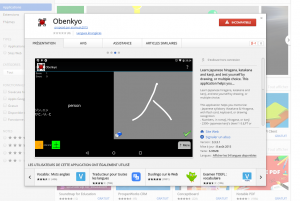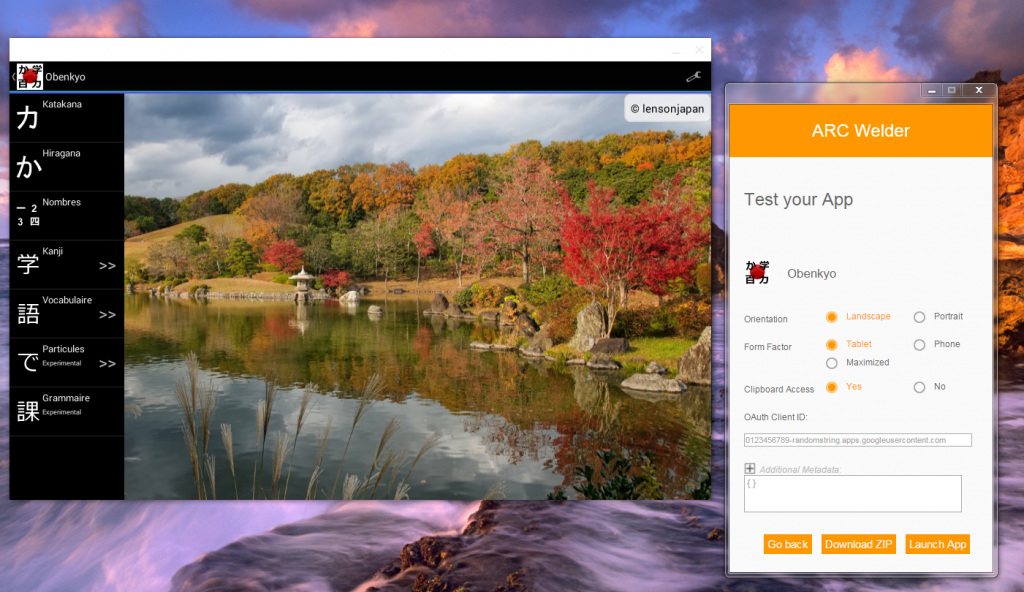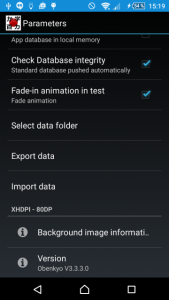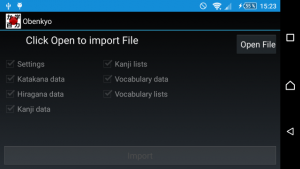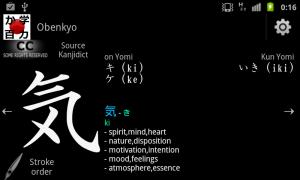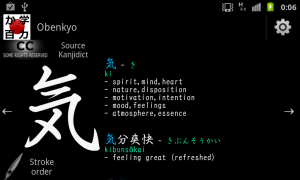Comme d’habiture, j’ai oublié de faire un post pour créditer le travail de ceux qui m’ont tant offert pour permettre à Obenkyo d’exister ? Tout ça grâce à la licence Creative Commons !
Voici la listes des projets sur lesquels Obenkyo est basé:
– KanjiVG – dessin de tous les kanji (base volontairement limité aux JLPT 1-5 et niveaux scolaires 1-8. Les informations ont parfois étés modifiés pour faciliter l’algorithme de dessin : ajout de tags, de dessins alternatifs …) – si vous voulez que j’ajoute d’autres kanji, laissez un message ou envoyez moi un mail.
– KanjiDict – Traductions, lectures, et informations des Kanji (Français, Allemand, Anglais et Espagnol)
– EDict – Ecriture, traductions et lectures du vocabulaire et tags d’information (pour le moment inutilisé, mais j’ai codifié chaque information sous la forme d’une lettre pour gagner de l’espace : verb = u …)
– JFrench – Traductions françaises du vocabulaire
– Tatoeba – Phrases et leurs traductions modifiés pour identifier les kanji, les mots en Hiragana, et les particules dans les phrases
– Tanos – Les informations ne sont pas sous CC, mais j’ai eu l’autorisation de les utiliser : découpage des JLPT pour les kanji et pour le vocabulaire
– Guide de grammaire Japonaise de Tae Kim – formidable guide de grammaire en CC traduit dans de nombreuses langues
– Icones pour valider/annuler les dessin modifiées de wikimedia (du travail de David Vignoni)
– Predicate Layout from Henrik Gustafsson (non changé)
– petites diodes permettant d’afficher le niveau actuel dans la page de vocabulaire provenant de Modernl (travail de Stuart Brown)
Et voici les fichiers
Fichier de base de données
Extraction de Kanjivg pour les Kana (en dehors de la base de données car plus compliqué à l’y intégrer
Icones modifiés du travail de David Vignoni
Pages du guide de Tae Kim’s guide en HTML modifiés pour un usage sur mobile/tablette (format modifié pour éviter les scrolls horizontaux pour faciliter le swite et changement des hyperlien en javascript)
Merci encore à toutes les personnes qui ont participé à ces projets, et je vous encourrage à participer à ces projets par n’importe quel moyen.As always, I forget to update the credits to thoses that allows Obenkyo to exist because of the Creative Commons licence.
Here is the project Obenkyo is based on:
– KanjiVG – Kanji Drawings (database limited to JLPT 1-5 & school levels 1-8. and some data modified to fit the drawing algorithm : added some tags, alternative view, …) – if you need other kanji, you can ask me to add them
– KanjiDict – Translation, readings and kanji information (French, English, German and Spanish)
– EDict – writing, translation and readings on the vocabulary and information tags (for now not used but I have coded this information to gain some space : verb = u …)
– JFrench – French translation of the vocabulary
– Tatoeba – Sentences and it’s translation modified to identify the kanji, katakana words and particles in sentences
– Tanos – Data is not under CC, but I got the authorisation to use the JLPT repartiton of kanji and Vocabulary
– Tae Kim’s grammar guide – Great CC guide translated in many languages
– Icons for drawing modified from wikimedia (fom David Vignoni work)
– Predicate Layout from Henrik Gustafsson (not changed)
– Small LED to show the actual level in vocabulary page from Modernl (from Stuart Brown work)
And here are the files:
DB File
Traductions extraction(French, English, German and Spanish) from KanjiDict
KanjiVg Extraction for kana
Tae Kim’s guide html pages in De,En,Es,Fi,Fr,Pt,Ru modified to fit into Android (layout changed to prevent horizontal scroll to help swipe & change hyperlink to javascript handle).
Icons modified from David Vignoni work
Once again, I want to thank everyone that are working on theses projects and to encourage everyone to help them in any means possible.

